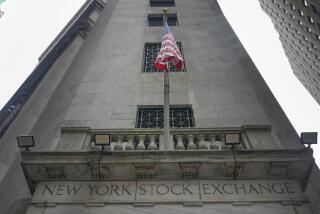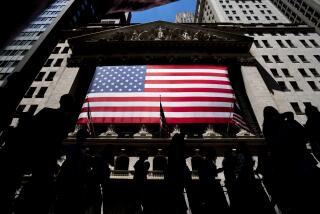Goldman Sachs profit tops $3 billion on strong trading
- Share via
NEW YORK — Throughout the last year’s financial crisis and this summer’s roaring recovery in the markets, Goldman Sachs Group Inc. has burnished its image as Wall Street’s premier firm, and its second straight quarter of blowout earnings kept the shine glowing.
The New York investment bank easily topped analyst forecasts Thursday, thanks to surging securities trading and reduced competition from beleaguered rivals. Third-quarter profit more than tripled to $3.2 billion from $845 million a year earlier. Its $5.25-a-share profit towered over analysts’ $4.18 consensus estimate.
“It was just another fantastic quarter for them,” said David Easthope, an analyst at Celent, a Boston research and consulting firm. “This quarter really reinforces the opinions that people have about Goldman Sachs.”
Goldman’s limited exposure to subprime-related assets helped it sidestep the billion-dollar losses that disabled some of its competitors. Its strong financial footing and willingness to take risk helped it seize opportunities as the crisis eased.
But Goldman also has been criticized for notching blockbuster profits and paying out huge bonuses -- especially so soon after repaying the $10 billion in government bailout money it received late last year.
Goldman earmarked $5.4 billion in the third quarter for bonuses and other compensation. It’s tucked away $16.7 billion so far this year, a 46% jump from a year ago. That’s an average of more than $527,000 for each of Goldman’s 31,700 employees.
Through the same period in 2007, its best year ever, Goldman set aside $16.9 billion, or $565,000 per employee, for bonuses and other additional compensation.
As if knowing what a hot-button issue bonuses were, Goldman gave $200 million to its own charitable foundation in the third quarter, twice its charitable contributions in 2007.
The only blemish on Goldman’s third-quarter earnings was that the company fell shy of its $3.4-billion profit in the second quarter.
Some areas, such as investment banking, also were comparatively weak.
Goldman shares slipped $3.65, or 2%, to $188.63 as some investors were disappointed that earnings weren’t even better. So-called whisper numbers circulating through Wall Street predicted a $6-a-share profit.
“Our second quarter was a record in virtually every single business,” said David Viniar, Goldman’s chief financial officer. “So [the third quarter] was a fantastic quarter, just not as fantastic as the second quarter.”
Several factors are helping Goldman.
Surging financial markets, especially for fixed income and commodities, boosted trading profits. Rivals’ continued troubles and reduced appetite for risk sent customers to Goldman, giving it more ability to charge higher fees.
Goldman’s minimal exposure to consumer-oriented businesses also let it sidestep some of the hits that have struck commercial banks as consumers struggle in a weak economy.
Overall, its results stood in contrast to those at Citigroup Inc., a Wall Street giant that is still operating with federal bailout funds. Citigroup eked out a third-quarter profit of $101 million only because it set aside less money than in the past to cover future loan losses.
But Citigroup reported a per-share loss of 27 cents because of charges associated with converting preferred shares held by the federal government into common stock. It had $8 billion in credit losses, down slightly from $8.4 billion in the second quarter.
Investors sent shares down 25 cents to $4.75 on Thursday.
Still, Citigroup raised eyebrows by setting aside only $802 million to cover expected future losses, a big drop from its $3.9-billion second-quarter provision and far less than analysts had expected.
That could foreshadow an improving economy, or it could force the company to take larger write-offs in the future.
--
More to Read
Inside the business of entertainment
The Wide Shot brings you news, analysis and insights on everything from streaming wars to production — and what it all means for the future.
You may occasionally receive promotional content from the Los Angeles Times.









